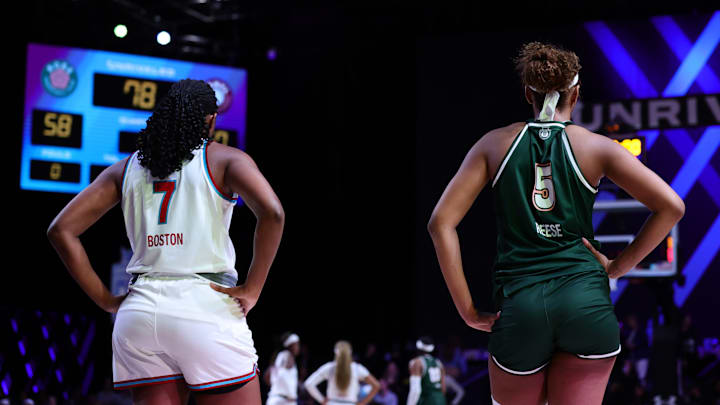Over the last several years, the WNBA has risen to prominence in sports media because the infusion of young talent has been exciting and undeniable. Many transformational players have graced the league since its inception in 1997, but the new wave of hoopers are growing the game like never before.
Both Chicago Sky forward Angel Reese and Indiana Fever big Aliyah Boston were considered stars at the college level, but their fandom and notoriety blossomed even more when they had instant success in the WNBA. Their respective rookie campaigns were among the best in recent memory, which captivated fan bases across the country and world.
While it is basically a fool's errand to compare such great talents, the WNBA35 exercise is important because it challenges us to analyze the best players in the league and how they truly stack up against one another. Aliyah Boston is ranked No. 22 in our rankings, and Reese is a few spots behind her at No. 27.
READ MORE: FanSided's WNBA35, ranking the best players in the WNBA this season
Aliyah Boston is ranked higher than Angel Reese in WNBA35
Boston not only has an extra year of experience on Reese, but she is already more decorated in her young career. She won the WNBA Rookie of the Year Award last season, whereas Reese finished second, and she has two All-Star appearances compared to Reese's one.
While part of this equation is unfair because Reese has only played a single year, it also serves to prove the point that Boston has been playing at a high level for longer. Her rookie campaign was backed up by another strong year, while Reese currently has a question mark before her sophomore season.
Last year, Bostons had a far better year statistically speaking, and her team was able to make the postseason. While she did have a stellar guard duo of Caitlin Clark and Kelsey Mitchell helping her out, Reese also had a strong supporting cast of Kamilla Cardoso and Chennedy Carter.
Still, Boston outperformed Reese, statistically speaking. She averaged 14.0 points per game, as well as 8.9 rebounds and 3.2 assists per contest. Although Reese led the league in rebounds per contest at 13.1 per game, she only contributed 13.6 points and 1.9 assists per contest.
Defensively speaking, Reese is a bit quicker with her hands, as evidenced by her 1.3 steals per game compared to Boston's 0.9, but when it comes to altering or blocking shots, Boston has the clear advantage. She was a feared defender in the paint, and she averaged 1.2 blocks per game as opposed to Reese's 0.5.
As far as scoring efficiency, the numbers are not particularly close either. Boston shot 52.9 percent from the field and 26.9 percent from the 3-point line, whereas Reese managed just 39.1 percent and 18.8 percent, respectively.
The gap between these numbers is massive, and there is a bit of truth to the fact that Reese's rebounding numbers may be slightly inflated because of her low shooting percentage. This has never been an issue for Boston, who is both incredibly efficient in the paint and more than capable from beyond the arc.
Reese has plenty of room to grow in Year 2, as does Boston in Year 3. Both the Chicago Sky and Indiana Fever made massive upgrades this offseason as well that should free up their young stars a bit and allow them to produce more.
Time may tell if these rankings are correct, but as with every WNBA debate, the opinions are nuanced and subjective. What Boston and Reese have done early in their careers both as players on the court and ambassadors off of it should be celebrated and there is no need to tear one down just to build up the other.
Boston and Reese will likely be some of the prominent faces of the league soon, and the margin for comparing them will become even more razor thin.
